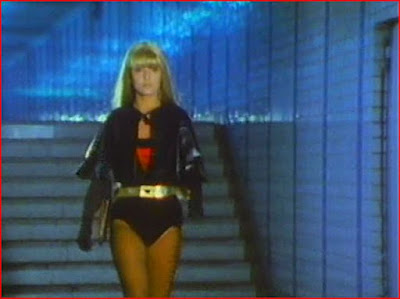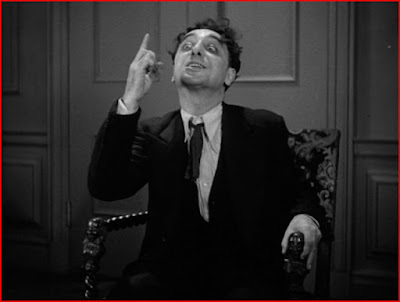 Happy Halloween! To mark the occasion, my friend Wendigo and I have dug up, with help from Netflix, a Golden Age quickie neither of us had seen before. Republic Pictures came late to the horror game, almost missing the classic era entirely but managing to release a couple of movies right around the same time Universal was winding down its horror unit and Val Lewton was making his last horrors for RKO. As might be expected from Republic, director Lesley Selander was a western specialist and would remain one afterward. The big novelty here is that Vampire's Ghost is the first screenwriting credit for Leigh Brackett, whose next was The Big Sleep and whose last was The Empire Strikes Back. Brackett co-wrote this script from her own adaptation of one of the founding works of vampire fiction, Dr. Polidori's Byron-inspired The Vampyre. Wendigo vouches for her fidelity to certain plot details from Polidori, while moving the action to Africa puts Vampire's Ghost in line with a Forties fad for voodoo that encompassed the Lewton unit's I Walked With A Zombie and the Lugosi horror comedy Zombies Over Broadway. Selander gets it all done in 55 minutes (IMDB says 59) and it proves pretty easy to sit through.
Happy Halloween! To mark the occasion, my friend Wendigo and I have dug up, with help from Netflix, a Golden Age quickie neither of us had seen before. Republic Pictures came late to the horror game, almost missing the classic era entirely but managing to release a couple of movies right around the same time Universal was winding down its horror unit and Val Lewton was making his last horrors for RKO. As might be expected from Republic, director Lesley Selander was a western specialist and would remain one afterward. The big novelty here is that Vampire's Ghost is the first screenwriting credit for Leigh Brackett, whose next was The Big Sleep and whose last was The Empire Strikes Back. Brackett co-wrote this script from her own adaptation of one of the founding works of vampire fiction, Dr. Polidori's Byron-inspired The Vampyre. Wendigo vouches for her fidelity to certain plot details from Polidori, while moving the action to Africa puts Vampire's Ghost in line with a Forties fad for voodoo that encompassed the Lewton unit's I Walked With A Zombie and the Lugosi horror comedy Zombies Over Broadway. Selander gets it all done in 55 minutes (IMDB says 59) and it proves pretty easy to sit through.The film opens with some self-pitying narration that proves to be spoken by the film's as-yet unseen vampire, for now known only by the ring on his finger as he invades an African hut to claim its female occupant. This is but the latest in a spree of mysterious exsanguination killings with puncture marks in the neck in common. The tribal drums suggest vampirism at work, but Julie Vance (Peggy Stewart) finds such talk about "a dead man denied Heaven" to be "medieval tommyrot." Suspicion naturally falls upon the new man in town, bar owner Webb Fallon (John Abbott) who hosts gambling and a sexy floor show, and all the early signs tend to confirm the suspicion. He doesn't like sunlight or mirrors, and he even grows weak when the local priest, Father Gilchrist (Grant Withers) clasps him on the shoulder. But he seems decent otherwise, can handle himself in a fistfight when a sailor accuses him of cheating (the ace Republic stuntmen predictably sell well for Abbott), can go about in the day (with dark glasses) and twice saves the life of Julie's boyfriend Roy (Charles Gordon). On the other hand, when he visits the Vance house, a servant notices that Fallon casts no reflection (the mirror promptly shatters) and the natives notice that a bullet seemed to pass through Fallon's body to wound another man when he joins an expedition to a restless village. Native vampire-hunter Simon Peter (Martin Wilkins) figures it all out and has the remedy: a spear dipped in molten silver.
But though his blow strikes home, Fallon prevails upon Roy to save him by placing his body on a hilltop (as in Polidori, Wendigo recalls) to receive the moonlight as his head rests on a box containing earth from his original grave. This rising again seems to justify the film's odd title, though Wendigo suspects from the number of times the phrase was used that the working title must have been "The Curse of the Undead," which would be used a decade later. The vampire has enough mesmeric power to prevent Roy from revealing what he knows (in Polidori, the vampire simply makes his friend swear an oath), but not from conspicuously ordering The Legend of the Vampires through the mail.
Webb Fallon is a man from Elizabethan England, a hero of the war with the Armada, who was cursed to undeath by causing the death of a woman. He's not exactly happy with his lot, but he doesn't shun his task of destroying happiness. He has an idea to make things easier for himself by turning Julie into his eternal companion, but Roy, Simon Peter and Father Gilchrist have other ideas....
For what it is -- most likely a second feature on a double bill -- Wendigo was impressed by The Vampire's Ghost and the trouble Brackett took to develop a vampire-hunting mythos that synthesized Christianity, voodoo and traditional folklore and graft it all onto the Polidori framework. Brackett and Selander found interesting new ways to envision a story and archetype that must have seemed very familiar by 1945, so that it doesn't seem like a Universal or Lewton knockoff. Wendigo liked the unassuming looking John Abbott's charismatic performance as an ambivalent vampire who can be likable yet proves himself an irredeemable villain. Webb Fallon is a cursed creature (not the victim of a vampire himself) whose curse taints everything he touches -- in a fit of generosity he hands some gambling winnings to a rummy who drops dead moments later, whether Fallon intended that or not. He's conscious of being cursed (though he's also capable of great luck at dice) and doesn't really like the idea, but he doesn't really mind existing, even if that means ruining other people's lives. Wendigo was particularly taken by the idea that Fallon has to work for a "living," though his choice of venue puts a lot of drifters conveniently in his path. Abbott's weak appearance underscores Fallon's vulnerability but also marks him as someone whose survival must be supernatural. Interestingly, he seems equally worried by manifestations of Christianity and voodoo, but less dedicated to Satanic evil than to the worship of a native "death god," and it's an understatedly progressive aspect of this film that Western religion and African "superstition" alike can contribute equally to the vampire's defeat, with the natives actually taking the initiative. Abbott is one of those actors who may not look like he should be playing a vampire, but Wendigo finds that a point in his favor, because it allows him to give a more original vampire performance. Charles Gordon does effective work as a hapless hero who knows what's going on but can't warn anyone until Father Gilchrist breaks down his mental blocks with the insight that Fallon can't maintain power over him unless Roy himself allows it. As Gilchrist, Grant Withers is adequate but his height, his bulk, his full-lenth priest's robe and his widow's peak strangely and risibly reminded us of Steven Seagal's vampire-fighter from Against the Dark. As Simon Peter, Martin Wilkins is allowed to be more intelligent and articulate than other natives, but Wendigo felt he was still handicapped by the sort of stilted dialogue Hollywood assigned to foreign characters in general.
Because Fallon isn't quite the standard (i.e. Universal) vampire in his range of powers and weaknesses, Vampire's Ghost is a relatively unpredictable film that keeps you guessing about what it might take to defeat the monster. Will another spear stop him or do you need to burn him too? If you scatter his box of earth to the wind, does he really have a fortnight to go back to his grave and restock? The horror genre may have seemed tired to many observers by 1945, but Republic, Brackett and Selander proved that it was still possible to look at vampires with fresh eyes, just as most moviemakers decided to avert their gaze for a decade. Ghost's economy of storytelling makes it more watchable now than it may have seemed at the time, and it made us feel that the Golden Age didn't necessarily need to end when it did.
























































